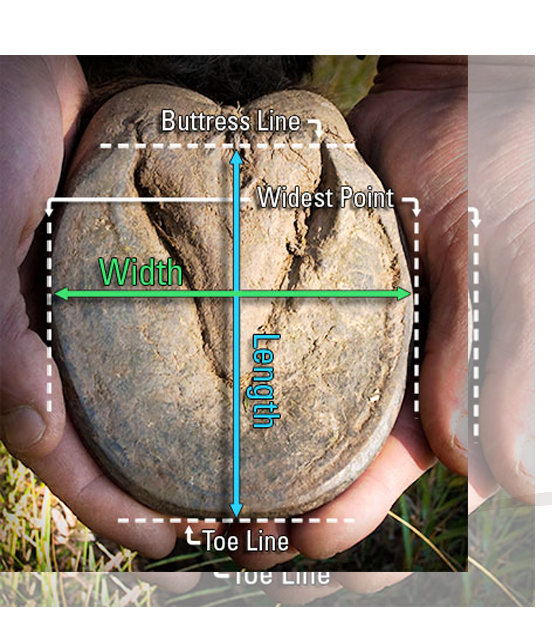BAREFOOTIN’
(bare-foot Pronunciation Key also bare-foot-ed adv. & adj. With nothing on
the feet: walking barefoot in the grass; a barefoot boy; a barefoot horse.)
DAROLYN ON BAREFOOTIN’
“BAREFOOTIN” happens to be my most favorite subject in the world … right up there with endurance riding. In fact, it seems my life now is ridin’, trimmin’, or talkin’ about one or the other.
We maintain about 70 horses at Cypress Trails Ranch in Humble (near Houston), Texas. Our focus and obsession is endurance, but since not one of us has figured out how to make a living at it, my horses have to work for a living by taking our customers on trail rides. Several of the horses are board horses and some of those help their owners by serving as riding horses for our daily trail rides. Oh … did I mention that each and every one of these horses is barefoot?
They live outside with other horses and they all manage to get their feet immersed in water every day. Those are the three requirements for successful barefooting. The correct physiological trim, living naturally and feet immersion in water, (replicating wild horses going into ponds and streams to drink).
Now if you had told me prior to September 2000, that I would even consider leaving a competing Endurance mount barefoot, running a 50 miler, or oh my gosh, a 100 miler, I would have told you that you were absolutely insane!

“HOW IT ALL STARTED”
On September 19, 2000 a reigning National Champion Endurance horse that I was riding a 100 mile race on “plunked out” at 80 miles. He was in excellent shape, it was flat terrain, it was hot, but he was used to it. I asked the vet (my request) to give him fluids to make him feel better, which he did, but the next day he started showing definite signs of laminitis. What was going on?
Having witnessed, through my own horses, and horses of friends, this insidious disease, and having watched at least eight of those so afflicted horses progressively grow worse and be put down, I panicked!
In retrospect and knowing what I know now, my theory is that most horses, and especially this one, develop a mild case of laminitis every time they compete on hard terrain in shoes. In this horse’s case he had run 4-5 competitions in the previous 5 months, shod and on hard terrain. Eventually, the laminae simply could not take it anymore. This also explains the rings that we see on our horse’s feet after a tough competition, weather, feed, or health change.
I rushed the horse to the best veterinarian hospital in Texas, and two weeks later, even though all the medicinal heroics had been applied, (including heart bar shoes), the horse was abscessing and worse. Enter a web page (actually 4 of them); I read until the wee hours of the morn, for four days straight. Convinced I had found the answer, I had my new farrier remove the heart bar shoes and do his best to do a natural trim from the directions I had printed off the Internet.
Two strokes of luck, (1) one of my boarders had a copy of “Lifetime of Soundness” and shared it with me, (2) a few days later, I located a Houston couple that had been nursing a severely foundered Friesian they had imported in early 1999. They had gone to Canada and spent two weeks with Sabine Kells, (the only “Certified Hoof Specialist” in North America at the time), to learn the trim.
The Friesian had “sole penetration” and everyone, including more than one veterinarian was encouraging them to put the horse down. Fast forward to July 2002 … this horse was at my barn, sound, showing off for Dr. Strasser. The only signs of previous founder being the telltale scars of the bedsores on the prominent bony areas. His owners were kind enough to assist and coach us in the initial trim of my champion horse.
My laminitic horse came sound… he ran his 1st race in January, four months after the injury. He almost won his 2nd race, and did win his third, “barefoot of course”.
My horses Oporto and Bronze Star ran 80 out of 100 miles barefoot in February 2001 of that year. In April both of them ran a 100 at the same site (sans the rocky road) and successfully completed. Granted, my heart was in my throat those first few races. The veterinarians were shaking their heads in disbelief. The horses hadn’t even been de-shod a whole year … but it was working.
CLINICS AND CONSULTATIONS
Darolyn is available as a speaker, individual trainer, as a team member for clinics, or to give consultations on any of her equine specialties.
She is happy to answer questions about barefoot trimming. Phone consultations are $25 per 1/2 hour, $40 per hour. Call 281.446.7232 to schedule your consultation or to get a quote for a consultation at your location.
Darolyn attends over two-dozen endurance competitions a year in the United States and abroad, she has been responsible for inspiring and mentoring hundreds of new endurance riders in Texas and beyond.
Darolyn offers half-day and full-day endurance clinics which can be booked online.
TEN YEAR PREDICTIONS FOR THE BAREFOOT MOVEMENT
- Ten years from now, I predict a good many farriers will not only be doing the barefoot trim, but tout that they always supported it.
- Ten years from now, I predict most upscale vets will have a Natural Trimmer on the payroll to quickly assist navicular, club footed, laminitic and foundered horses.
- Ten years from now, I predict 95% of all backyard pleasure horses will be kept barefoot.
- Ten years from now, I predict cutting, reining, roping, barrel, and race horses will be allowed the choice of performing barefooted, and as more and more of them win money, and have longer performance careers, the field will grow.
- Ten years from now, horse museums will house metal atrocities called therapeutic shoes on their walls, and people will look at them in disgust and amusement that man could have been so ignorant of how the foot actually works, that they would attempt to cure those ills with shoes, knowing what nature could heal much quicker and better left on its own.
- Ten years from now, 10,000 trimmers will have saved 1,000,000 horses from retirement and/or death by giving them healthy feet. Shoeless, Not Clueless!!! Darolyn Butler with 40,000 Endurance Miles to her credit has over 60 barefoot horses working and competing successfully. Natural Trim consultation and trimming available. See Hoof Grooming Price List in Horse Boarding tab for pricing.
Barefoot trimming clinics are given from time to time at Darolyn’s home stable, or she may be contacted for off-site clinics.
